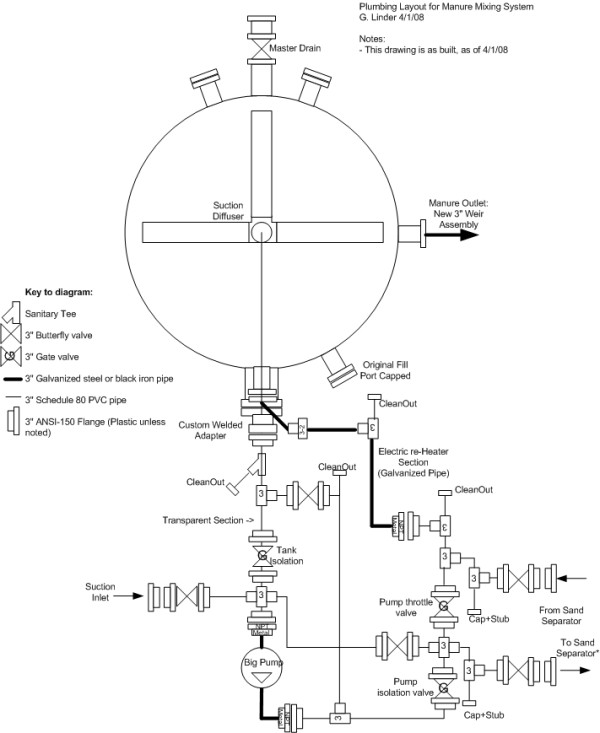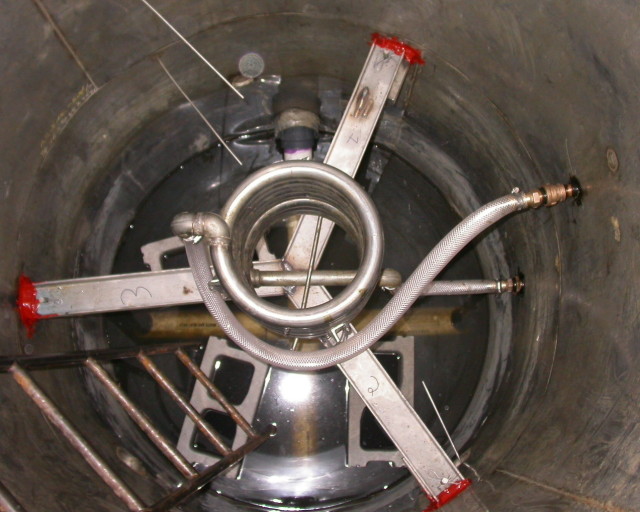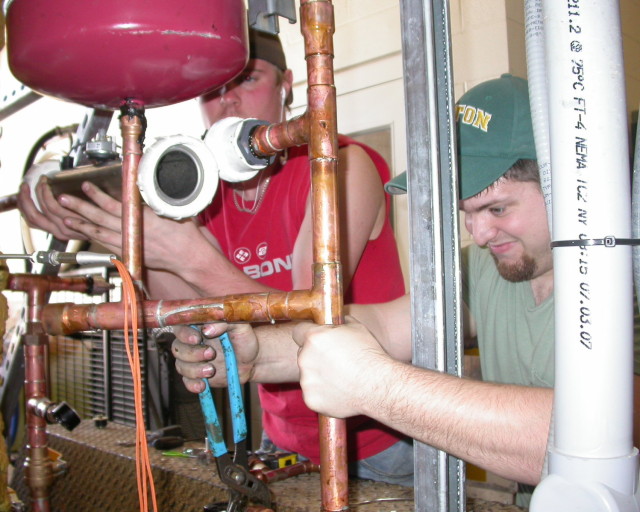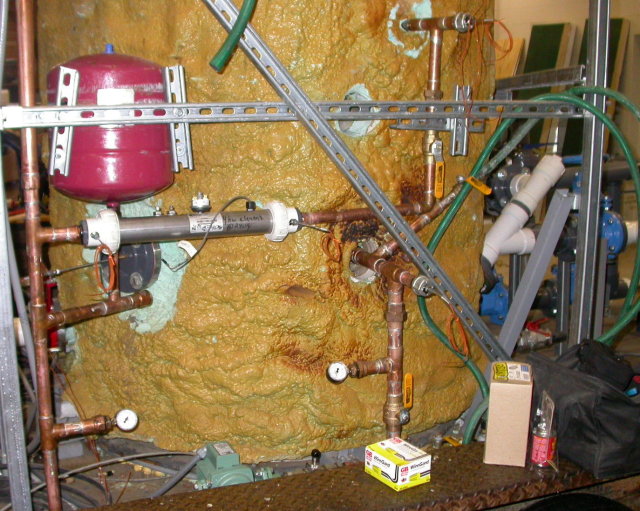Poop Digester Version 2: The Resurrection
 If you are a biblical type, death can occasionally result in resurrection.
This photo shows the crew that brought the Clarkon Digester back from the dead.
The handsome tall guy in the back standing is me, to the left with the glasses is
Dan, and in front is Shaun.
If you are a biblical type, death can occasionally result in resurrection.
This photo shows the crew that brought the Clarkon Digester back from the dead.
The handsome tall guy in the back standing is me, to the left with the glasses is
Dan, and in front is Shaun.
We are posing with the finished 3 inch plumbing
for the manure circulation system, after having finished tightening it all up.
Shaun was a summer hire by the professor in charge of the project, and
was great to have. At the time of writing, he is keeping things going
and developing sand removal technologies with the rest of the crew at
Clarkson. Dan just showed up one day and asked what was going on.
Turns out he needed new tires for his 'Rusty Shitbox Truck', so
he put in a number of hardcore days getting things going with us,
while still working many hours for his other research projects.
The 'jaunty angle' that the pipes seem to be at is not an illusion.
There's a welded flange on the bottom of the tank which replaced the
sand removal auger, and I stuffed up the orientation of that, so
that it tilted funny on the plumbing's horizontal axis.
The jaunty angle ended up helping us out a bit, but it does
make it look a little experimental.
 Here is a diagram view of plumbing system. This differs significantly from
the earlier system, which depended on a big gas blower for tank
mixing. Due to the tank being original from last semester, we inherited a
couple of places where the plumbing is too small: Notably on the
output to the new 3 inch weir (only 1.5 inch pipe on the tank),
and the manure inlet port (only 2 inch pipe on the tank).
Here is a diagram view of plumbing system. This differs significantly from
the earlier system, which depended on a big gas blower for tank
mixing. Due to the tank being original from last semester, we inherited a
couple of places where the plumbing is too small: Notably on the
output to the new 3 inch weir (only 1.5 inch pipe on the tank),
and the manure inlet port (only 2 inch pipe on the tank).
During construction, we constantly were making observations about how
handy bolt flanges are. A large number of nuts, bolts, and washers
is needed to make it work, but it makes replacing things a
breeze compared to cutting and fitting in new pieces to the cut pipe.
 A view inside the digester tank itself. The thin sticks poking in
from the side are the thermocouple probes. There are four probes
in all in the tank each containing three thermocouple
elements. At the bottom, forming a plus sign between the
cinder blocks, is the suction diffuser. The idea here being that it
is harder to block up three different 3 inch openings than just one.
A view inside the digester tank itself. The thin sticks poking in
from the side are the thermocouple probes. There are four probes
in all in the tank each containing three thermocouple
elements. At the bottom, forming a plus sign between the
cinder blocks, is the suction diffuser. The idea here being that it
is harder to block up three different 3 inch openings than just one.
The spiral coil is stainless steel, and was original equipment from
the previous digester. The bracket that holds the heater is also
all stainless steel, welded to the outside of the tank with a
buzz box and a fair amount of patience. The cinderblocks in the bottom
are there to keep our feet dry, as the tank always has a few inches
of liquid, due to the location of the bottom drain.
The heater fluid is supplied at the bottom and returns via the top,
going through the small feed-throughs in the side. Originally
these presented a problem, due to various weld, thread, and
sealing issues. These problems were solved, and the heater
system is entirely closed.
 Here's Shaun and his roommate installing plumbing in the heater system.
This guy has a real good hand with a torch, and helped out a lot in
the various revisions to the heater system. Both are students in
SUNY Canton's renewable energy program.
Here's Shaun and his roommate installing plumbing in the heater system.
This guy has a real good hand with a torch, and helped out a lot in
the various revisions to the heater system. Both are students in
SUNY Canton's renewable energy program.
 An poor photo of the finished but uninsulated heater system. The big red
tank is an expansion tank. The silver item in the middle is the 5 KW
flow through heater element. There are four thermocouples in the heater
system, two at both ends of the heater element, and two in the
inlet and outlet from the spiral coil in the tank.
An poor photo of the finished but uninsulated heater system. The big red
tank is an expansion tank. The silver item in the middle is the 5 KW
flow through heater element. There are four thermocouples in the heater
system, two at both ends of the heater element, and two in the
inlet and outlet from the spiral coil in the tank.
At the bottom,
just visible behind the fender of the trailer, is the green circulating
pump and what I had dubbed the 'Saturn 5 Flowmeter'. The little
black cap covers the connectors to a PotterMeter that came
out of one of Clarkson's closets, and is stamped with all
kind of 1950-sounding rocket-sounding acronyms. Turns out the
people that made this also made the meters for the Saturn 5
rocket, hence the rocket-part reference. It is a very nice
turbine flowmeter, and utter overkill for this application.

